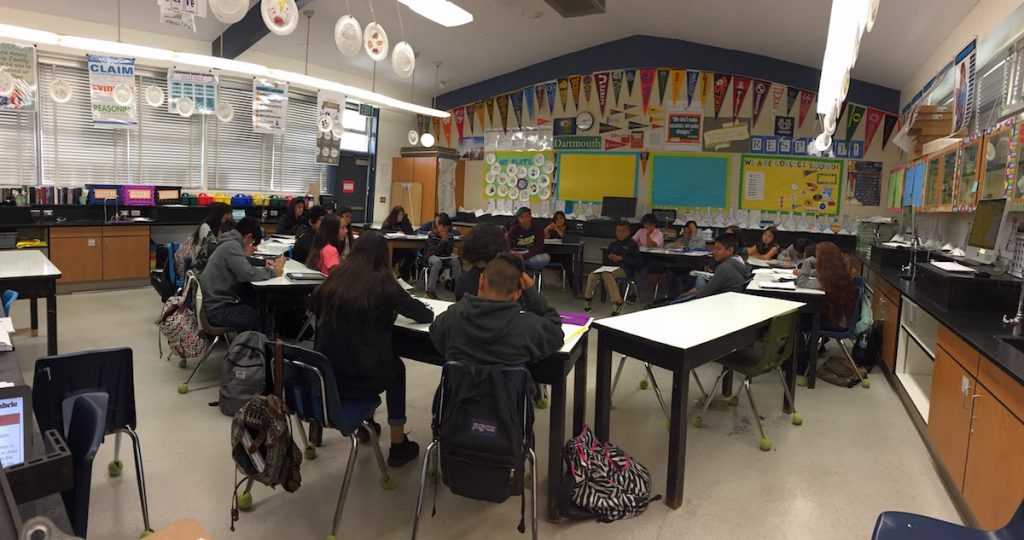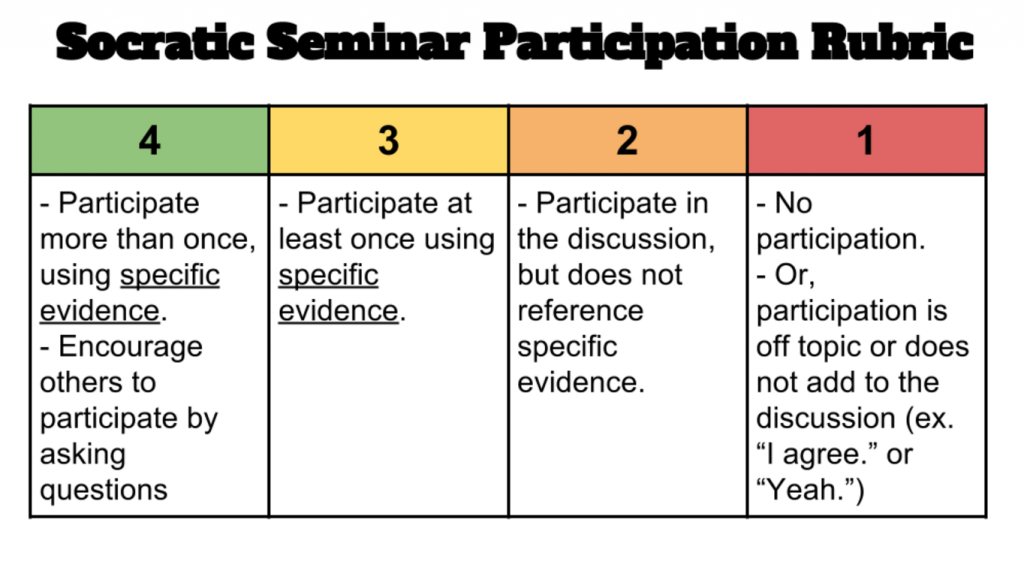How to Promote Critical Thinking with Socratic Seminars
- April 18, 2017
- By Mari Venturino
As teachers, we’re constantly being told to implement 21st Century Skills and the “4Cs” (critical thinking, communication, collaboration, creativity). However, beyond that, we frequently aren’t sure where to begin.
To tackle each of the “Cs,” one of my favorite activities to do with my 7th grade science classes is a Socratic Seminar. Although Socratic Seminars take some preparation for both the teacher and the students, the outcome is well worth the effort! The goal is to get students to dive deep into what you’ve covered in class and think critically about the topic at hand.
A Socratic Seminar is a student-led discussion where part of the class is in an inner circle speaking, and the other part of the class is in an outer circle observing. In my classroom of 30 students, I put students in groups of 3, with one speaker and two “wing people” observing. These jobs rotate at set time during the discussion (more on this below).

My role as the facilitator is to silently watch the discussion from outside both circles. I make notes on who participates, who refers to the text and/or classroom activities as evidence, and I silently redirect students who get distracted. I also give instructions when we rotate jobs. During the discussions — as much as I want to — I don’t chime in!
To prepare for a Socratic Seminar, we read at least two articles in class on a topic. Our most recent Socratic Seminar was on the human impact on ecosystems.
Our preparation included:
- Reading news articles about micro trash, pollution, and how human activities change ecosystems
- Using Google Expeditions to go on a virtual field trip to Borneo to observe how humans have impacted the rainforests through deforestation, land encroachment, and agriculture
- Watching The Lorax movie and talking about how that ecosystem was affected by the “Once-ler”
- Studying the California Condor rescue and re-population efforts
Having a wide variety of multimedia sources is essential for a successful Socratic Seminar.
Here’s how to set up a Socratic Seminar in your class:
First, I provide students with a few open-ended questions a day or so before the seminar, and have them brainstorm their responses. Each student receives a paper copy of the “Socratic Seminar Preparation & Student Handout” to prepare (make a copy here). You’ll notice there is a blank page in the middle. This is intentional. When printing & copying back-to-back, this ensures that the two observation sheets are single-sided.
I also ask students to write out a few of their own “Higher Level” questions that they can ask the class.
The day before, I volunteer a few students to set up my classroom with 10 chairs in an inner circle, and 20 chairs with desks to form an outer circle. (Modify based on your class size. In general, each “participant” or speaker will have 1-2 observers.)
When students walk in, I assign them into groups of three. Sometimes these groups are randomized, other times they are intentionally grouped based on personalities and strengths.
Person A sits in the inner circle, and the other two teammates, Persons B & C, sit in the two chairs directly behind Person A.
Socratic Seminar jobs:
- Speaker: The speaker participates in the discussion with the rest of the speakers, taking turns to share ideas. The speakers ask their own questions, and guides the discussion.
- Body Language Observation: This wingperson is responsible for observing the body language of their speaker. They mark off different characteristics, such as “spoke in the discussion” or “looked at the person who was speaking.” They are silent during the discussion.
- Content Observation: This wingperson observes what is said during the discussion. They write down notes on both what their speaker said, and summarize what the rest of the speakers say. They are silent during the discussion.
The Socratic Seminar runs in three rounds, so that each person has a chance to do each role. Since I teach on a block schedule with 100 minute periods, it is easy to have students complete the whole Socratic Seminar during class. It can be spread over two days if needed.
Each round breaks down to:
- 1.5 minutes: “Speaker, turn to your wingpeople and brainstorm questions and ideas you’d like to bring up in the conversation.”
- 15 minutes: “Speakers, turn back to the center. You may begin.” [This is all I say — it’s ok if it takes 30+ seconds before someone talks!]
- 2 minutes: “Speakers, stay silently facing the center. Wingpeople, you have 2 minutes to answer the ‘after discussion’ questions.”
- 1.5 minutes: “Speakers, turn to your wingpeople. Wingpeople, each of you share 1 thing your speaker did well, and 1 thing they can work on for next time.”
- 1 minute: “If you were speaker, move to content. If you were content, move to body language. If you were body language, move to speaker.”
Then, start back at the beginning for the next round.
Each round lasts 21 minutes, and with 10 minutes for initial instructions and set-up, and another 15 minutes for the final reflection, the whole process can be done in about 90 minutes.
At the end of the Socratic Seminar, students remove the two observation sheets from their packet and give them to the people they were observing. They receive the observations from when they were the speaker, and re-staple their packet. And finally, students complete the reflection on their participation.
My students also self-grade their participation in the Socratic Seminar based on this rubric:
Socratic Seminars are great ways to get students thinking deeply before a larger writing assignment. Many students benefit from talking through their ideas before they write. Even if you’re not doing an essay or a term paper, you can have students write a Claim-Evidence-Reasoning paragraph based on one of the questions discussed in the Socratic Seminar. Read more about how to scaffold a CER here.
(Featured image c/o kali9/Shutterstock)

Kids Discover Talks with Book Editor Karen Cicero about Good Housekeeping’s 2025 Kids’ Book Awards
- December 22, 2025

Kids Discover Talks with Television Lighting Designer Christopher Landy About the Rockefeller Center Christmas Tree Lighting
- December 9, 2025

It’s the Most Wonderful Time of the Year… For Community Service Projects!
- December 8, 2025